
Alternative III suggests physically moving the confluence approximately 700 ft (213 m)
upstream by modifying both branches of the tributaries with excavation, fill, and bank
protection. The grade control and the deposited material behind the control would be removed.
This conceptual design is shown in Figure 10.26. This alternative has most of the advantages
that are provided by Alternative II and does not require relocation of the road right-of-way.
However, the cost of modifying the channels can be significant and may be prohibitive.
The results of low chord and total scour analyses are presented in Table 10.10. The freeboard
requirement for debris was determined qualitatively. Pier scour was estimated with and without
a vegetative debris accumulation. A maximum debris width of 5 ft (1.5 m) was assumed for
this analysis. Long-term degradation assuming a 25 percent reduction of sediment supply due
to urbanization and gravel mining activities was added to the degradation calculated for the
100-year flood.
Table 10.10. Low Chord and Total Scour Requirements at Craycroft Road.
Water
Degradation (ft)
Alternative
Surface
Aggradation
25% Reduction in
(ft)
(ft)
100-Year Flood
Sediment Supply
I
2435.6
1.7
0.5
2.6
II
2431.0
4.6
0.8
2.6
III
2434.4
0
0.8
2.6
Vegetative
Pier Local Scour (ft)
Minimum
Total Abutment
Total Pier
Debris
Low Chord
Local Scour
Scour
Scour
Without
With
Freeboard (ft)
(ft)
(ft)
(ft)
(ft)
Debris
Debris
3.0
2441.7
11.1
5.0
7.8
14.2
10.9
3.0
2437.7
13.2
7.0
10.9
16.6
14.3
3.0
2439.5
13.2
7.0
10.9
16.6
14.3
As mentioned, the grade control on Pantano Wash near the confluence with Tanque Verde
Creek is temporary in nature and is likely to fail during a major flood. Sudden failure of the
grade control can cause instability of the banks and the new bridge. It is recommended that
the grade control be removed, or at least the bridge design should consider the consequences
of its sudden failure.
The alignment of the flow is a major concern when building a bridge in the vicinity of a
confluence. Poor flow alignment can cause serious local scour problems. Circular piers are
strongly recommended in this situation to minimize local scour.
Although the probability of simultaneous occurrence of the two peak flows at the bridge site
may be small, the impact on the proposed bridge due to such an event should be considered.
One way to account for such an occurrence is to design the Craycroft Road Bridge with an
extra margin of safety, both hydraulically and structurally.
In selecting the best alternatives for the Craycroft Road Bridge, economic, social and
environmental constraints must be considered. Based upon this preliminary evaluation, both
Alternatives I and III are more attractive than Alternative II. Alternative II has the disadvantage
of a potential for both significant aggradation and degradation, which increases the cost of
design. The acquisition of the right-of-way to realign the bridge in Alternative II may be
prohibitive.
10.36




 Previous Page
Previous Page
